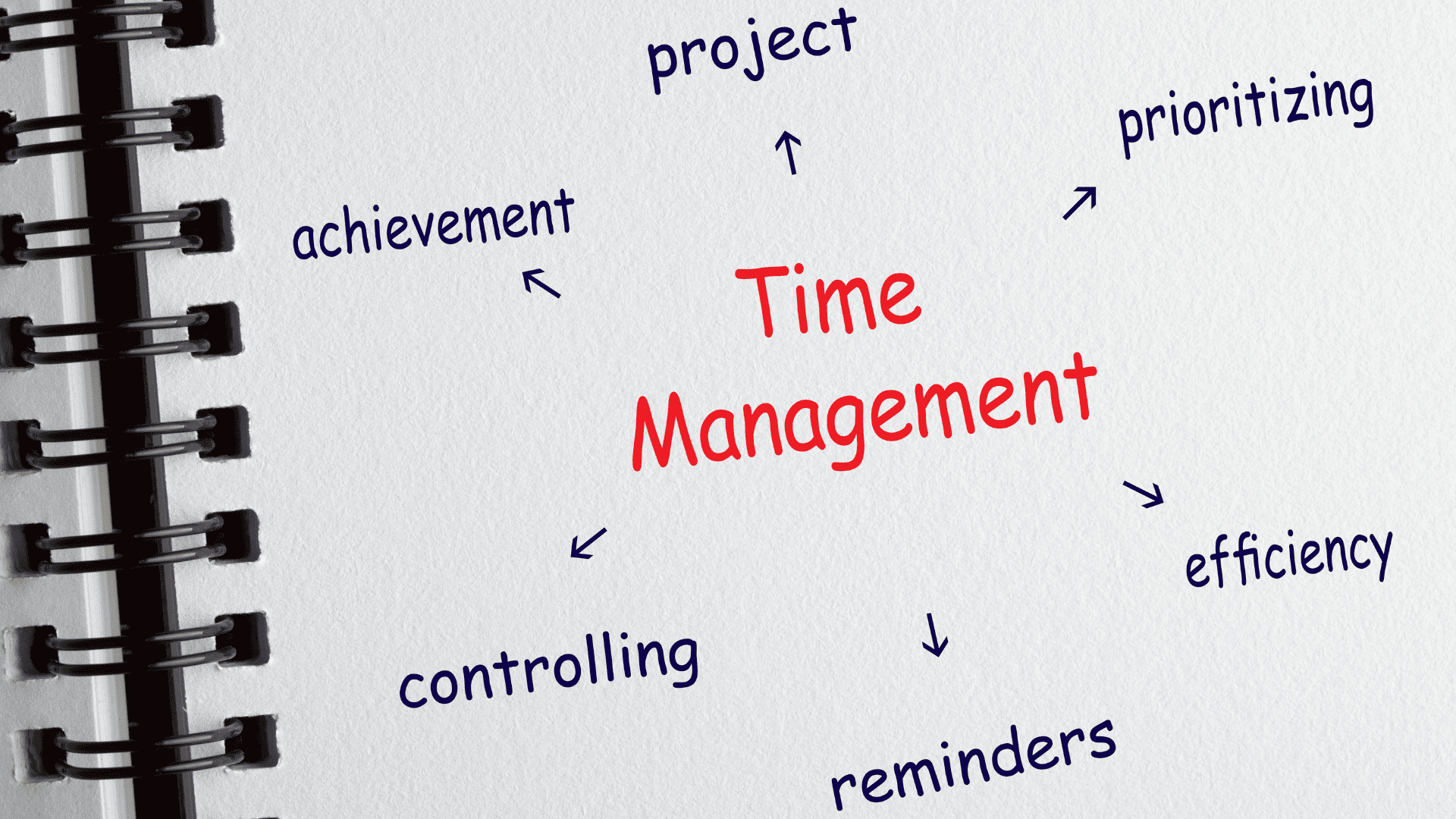Category Archives for "Self-growth"

In today’s fast-paced work environment, being a busy professional is often synonymous with being constantly overwhelmed. With competing priorities, tight deadlines, and an ever-growing to-do list, it can feel like there’s never enough time in the day to get everything done. However, mastering the art of time management can help you take control of your schedule, boost productivity, and achieve your goals with greater efficiency.
Here are some practical time management techniques to help busy professionals maximise productivity:
Remember, effective time management is not about working harder but working smarter. By implementing these time management hacks into your daily routine, you can optimise your productivity, reduce stress, and achieve better work-life balance as a busy professional. So, take control of your time, prioritise your tasks, and watch your productivity soar.
Want to join our FREE masterclass on time management where we go deeper into the above points with tools for each hack? Join our community HERE.

In the fast-paced world we live in, success often seems like a distant goal, achievable only by those who possess extraordinary talent or luck. However, one often overlooked factor that can significantly contribute to success is the implementation of a well-crafted daily routine. A routine provides structure, discipline, and efficiency to our lives, enabling us to make the most of our time and resources. In this article, we’ll delve into the benefits of a routine and offer practical tips for creating one that fits your unique needs.
A well-designed routine helps eliminate decision fatigue by automating mundane tasks and creating a clear roadmap for the day. This allows you to focus your energy on high-priority tasks, thereby boosting productivity and efficiency.
By allocating specific time slots for different activities, a routine helps you make better use of your time. It prevents procrastination and ensures that you allocate sufficient time to important tasks without neglecting other areas of your life.
Knowing what to expect each day can significantly reduce stress and anxiety. A routine provides a sense of stability and control, making it easier to navigate through the challenges and uncertainties of daily life.
Contrary to popular belief, a routine doesn’t necessarily equate to a monotonous existence. Instead, it allows you to strike a balance between work, personal life, and self-care activities. By incorporating time for relaxation and leisure, you can prevent burnout and maintain overall well-being.
Begin by clarifying your long-term goals and identifying the activities that align with them. Prioritise tasks based on their importance and urgency, ensuring that your routine reflects your overarching objectives.
Don’t overwhelm yourself by trying to implement drastic changes overnight. Instead, start with small, manageable adjustments to your daily schedule. Gradually introduce new habits and routines, allowing yourself time to adapt and establish consistency.
The way you start your day sets the tone for the rest of it. Create a morning ritual that energizes and prepares you for the day ahead. This could include activities such as exercise, meditation, journaling, or a healthy breakfast.
Divide your day into blocks of time dedicated to specific tasks or categories of activities. Allocate sufficient time for work, personal projects, relaxation, and social interactions. Use tools like calendars or productivity apps to schedule and track your activities effectively.
While routines provide structure, it’s essential to remain flexible and adaptable. Life is unpredictable, and unexpected events may disrupt your plans. Embrace these changes gracefully and adjust your routine as needed, without losing sight of your long-term goals.
Regularly evaluate the effectiveness of your routine and make adjustments as necessary. Reflect on your progress, identify areas for improvement, and incorporate feedback from your experiences. A routine is a dynamic process that evolves over time to suit your changing needs and circumstances.
In conclusion, building a daily routine is a powerful tool for achieving success in both professional and personal endeavours. By harnessing the benefits of structure, discipline, and efficiency, you can optimise your time and maximise your potential. Remember to tailor your routine to suit your unique goals, preferences, and lifestyle, and don’t hesitate to modify it as you grow and evolve. With dedication and perseverance, a well-crafted routine can pave the way for a fulfilling and successful life.

In today’s fast-paced and ever-evolving world, success isn’t just about what you know; it’s about how you approach learning and development. One of the most powerful tools for achieving success in both personal and professional realms is the concept of a growth mindset.
So, what exactly is a growth mindset? Coined by psychologist Carol Dweck, a growth mindset is the belief that our abilities and intelligence can be developed through dedication and hard work. In contrast, a fixed mindset is the belief that our talents and capabilities are innate and unchangeable.
Adopting a growth mindset means embracing challenges, persisting in the face of setbacks, seeing effort as a path to mastery, and learning from criticism. It’s about viewing failures not as signs of incompetence but as opportunities for growth and improvement.
Here are a few key reasons why cultivating a growth mindset is crucial for personal and professional success:
So, how can you cultivate a growth mindset?
By adopting a growth mindset, you can unlock your full potential, embrace new opportunities, and achieve success in all areas of your life. So, challenge yourself, embrace failure, and never stop learning and growing. The possibilities are endless when you cultivate a mindset focused on growth and development.
Want to associate with others having the growth mindset and in their transformation journey? Join our FREE community of trend setters HERE.

In the pursuit of our goals, whether personal or professional, we often find ourselves fixated on the grand achievements—the big promotions, the major milestones, the monumental successes. While these are undoubtedly worth celebrating, it’s equally important not to overlook the significance of small wins along the way. These smaller victories may seem inconsequential at first glance, but they play a crucial role in keeping us motivated and propelling us forward on our journey.
Acknowledging and celebrating small wins is more than just a feel-good gesture; it’s a powerful tool for maintaining momentum and sustaining motivation over the long haul. Here’s why embracing the concept of celebrating small wins can make a big difference in your success journey:
So, how can we effectively celebrate small wins in our personal and professional lives?
In conclusion, celebrating small wins is not about trivializing our achievements but rather about recognizing the journey and the progress we’ve made along the way. By embracing the power of small victories, we can stay motivated, inspired, and focused on reaching our ultimate goals. So, let’s celebrate every step of the journey, no matter how small, and keep moving forward with confidence and determination.
Join a community of like minded people where everyone cheers for your every little success.

In a world that often feels fast-paced and chaotic, it’s easy to get lost in the hustle and bustle of everyday life. We find ourselves chasing after goals and dreams without truly understanding why we’re pursuing them in the first place. However, finding your “why” — your purpose — is not just a philosophical pursuit; it’s a powerful tool that can fuel motivation, drive success, and bring a sense of fulfilment to our life and work.
Identifying your purpose provides you with a guiding light, a North Star to navigate through life’s challenges and opportunities. When you know why you do what you do, every action becomes more intentional and meaningful. Purpose acts as a source of motivation during tough times, a beacon of hope when you face setbacks, and a catalyst for resilience in the face of adversity.
Moreover, purpose gives your life a sense of direction and clarity. It helps you prioritise your goals and make decisions that align with your values and aspirations. When you’re clear about your purpose, you’re less likely to be swayed by external pressures or societal expectations. Instead, you become the architect of your own destiny, shaping your life according to what truly matters to you.
Think about the activities or subjects that make you come alive. What are you naturally drawn to? What makes you lose track of time? Your passions often hold clues to your purpose, indicating what you deeply care about and what brings you joy.
Your values are the principles that guide your behaviour and decision-making. Reflect on what matters most to you in life — whether it’s honesty, compassion, creativity, or justice. Your purpose is often connected to living in alignment with your core values.
Take inventory of your strengths, talents, and skills. What are you good at? What do others admire about you? Your purpose may involve using your unique abilities to make a positive impact in the world. Sometime you may struggle to find your strength as it is a part of you since your birth. There is a famous book called Strength Finder from Gallup which you could use to easily find your strength.
Your past experiences — both positive and negative — can offer valuable insights into your purpose. Reflect on the challenges you’ve overcome, the lessons you’ve learned, and the moments that have shaped who you are today. Often, your purpose emerges from turning your pain into purpose or using your struggles to help others.
Pay attention to your intuition and gut feelings. What is your inner voice telling you? Sometimes, your purpose reveals itself through moments of inspiration or inner knowing.
Don’t be afraid to experiment and try new things. Your purpose may evolve over time, so stay open to exploring different paths and possibilities. Be willing to step outside your comfort zone and embrace the journey of self-discovery.
In a world filled with distractions and noise, finding your purpose is like finding the missing piece of a puzzle — it brings everything into focus and gives your life greater meaning and significance. By identifying your why, you unlock a reservoir of motivation, resilience, and fulfilment that propels you toward success in both your personal and professional endeavours.
So, take the time to reflect, explore, and listen to your inner voice. Your purpose is waiting to be discovered, ready to ignite your passion and propel you toward a life of purposeful action and fulfilment. Embrace the journey, and remember that the power of purpose lies within you.
Are you struggling to find your purpose in life? Why not join our FREE masterclass on Finding your purpose by joining our community HERE.

Procrastination – the perennial enemy of productivity and progress. We’ve all been there: putting off tasks until the last minute, allowing distractions to hijack our focus, and watching deadlines loom ominously closer. Yet, overcoming procrastination is not an insurmountable challenge. With the right mindset and strategies, you can conquer procrastination and achieve your goals effectively. Here are some actionable tips to help you on your journey:
Remember, overcoming procrastination is a gradual process that requires consistency and perseverance. By implementing these actionable tips and strategies, you can cultivate habits that empower you to tackle tasks head-on and achieve your goals with confidence. Embrace the journey, stay resilient, and watch as your productivity soars to new heights.
Do you want to take our FREE master class on “Overcoming Procrastination” and have an accountable partner for yourself? Join our FREE community HERE.

In today’s fast-evolving professional landscape, the ability to acquire new knowledge and skills swiftly is a critical determinant of success. Among the myriad of learning strategies available, the Feynman Technique emerges as a standout approach for its effectiveness and simplicity. This method, named after the renowned physicist Richard P. Feynman, is celebrated for its ability to distill complex ideas into digestible, understandable pieces. Here’s how you can harness this technique to enhance your learning efficiency.
The Feynman Technique is built on the premise that the best way to understand something deeply is to teach it to someone else. It encompasses four straightforward steps that guide learners through a process of simplification and review. They are as below:
1. Select a Topic: Start by picking a topic you wish to learn and note it down.
2. Explain Like You’re Teaching a Young Student: Attempt to explain the topic as if you were explaining it to a young learner. Avoid using complex terminology and aim for simplicity. This step challenges you to refine your understanding to its core elements.
3. Spot Gaps and Revisit Your Study Materials: Should you stumble upon areas that are hard to simplify, it’s a cue to return to your study materials for a deeper dive. Continue this process until you can articulate the concept in elementary terms.
4. Refine and Streamline: Re-examine your explanation and strive to make it even more straightforward. Employ analogies or simple comparisons to aid comprehension.
But why is it so effective? The effectiveness of the Feynman Technique can be attributed to several factors:
– Clarification: It necessitates the distillation of complex ideas to their essence, fostering a solid understanding.
– Active Engagement: Explaining a concept activates recall processes, enhancing memory and comprehension.
– Gap Identification: It naturally illuminates areas of weak understanding, guiding learners on where to focus their study efforts.
– Participation: Engaging directly with the material promotes better retention compared to passive learning methods.
Professionals can apply the Feynman Technique to master new competencies, grasp industry-specific concepts, or even enhance their communicative and pedagogical skills. Here are some applications:
– Lifelong Learning: Apply this method to keep up with the latest trends in your field or to acquire new competencies that can propel your career forward.
– Enhancing Presentation Skills: Utilise this approach to ensure that your presentations are accessible and comprehensible to audiences with varying levels of expertise.
– Promoting Team Learning: Foster a learning culture within your team by encouraging members to share knowledge using this method, thereby enhancing collective skill sets and understanding.
The Feynman Technique transcends being merely a study tactic; it is a philosophy for learning and understanding that can be applied throughout one’s professional journey. Its deceptive simplicity is what makes it incredibly powerful, offering a pathway to not just faster learning, but also to a deeper grasp of complex material. In the dynamic world of professional development, being an adept learner gives you a distinct edge, and the Feynman Technique is your ally in achieving that proficiency.

In the world of entrepreneurship and direct selling, Amway has emerged as a prominent player, offering individuals an opportunity to build their own business and achieve financial independence. In this blog post, we will delve into the essence of Amway, exploring what it is and how individuals can make money within the Amway business model.
Amway, short for the “American Way,” is a multinational direct selling company that has been in operation since 1959. The company offers a wide range of consumer products, including health and wellness supplements, personal care items, household cleaning products, and more. The health supplements are sold under the brand name of Nutrilite, which is a leading manufacturer of natural nutritional supplements (as opposed to synthetic supplements) in the world. Amway operates on a multi-level marketing (MLM) model, which means that independent distributors are the driving force behind the company’s sales and growth. Amway products are are very well known around the world due to their high quality.
Amway’s business model revolves around the concept of relationship marketing, where distributors build a network of customers and also recruit and mentor others to become distributors. This network of distributors forms the foundation of Amway’s sales structure, enabling individuals to earn income through product sales and team building.
As an Amway distributor, it is essential to have a thorough knowledge of the products you are representing. Familiarize yourself with their benefits, ingredients, and usage instructions. This knowledge will help you confidently promote and sell the products to potential customers. There are a lot of people searching for Amway near their home. Hence, having a website or social media channels will automatically attract potential customers.
One way to make money in Amway is by building a loyal customer base. Focus on providing exceptional customer service, understanding your customers’ needs, and offering tailored product recommendations. Building strong relationships with your customers will lead to repeat purchases and positive word-of-mouth referrals.
To expand your Amway business, it is important to recruit and mentor new distributors. Share your knowledge and experiences with them, provide training and support, and help them understand the business model and products. As your team grows, you earn commissions based on their sales volume.
Successful Amway distributors often emphasize personal growth and development. Attend training sessions, seminars, and conferences organized by Amway to enhance your skills in areas such as sales, communication, leadership, and entrepreneurship. Constantly learning and improving will contribute to your success in the Amway business.
In today’s digital age, utilizing online tools and social media platforms can significantly enhance your Amway business. Create a professional online presence, showcase Amway products, share success stories, and engage with potential customers and recruits. This approach can help expand your reach beyond your immediate network.
Amway has operations in more than 100 countries with India (Amway.in) being the fastest growing market in the world.
Amway offers individuals an entrepreneurial opportunity to create their own business, achieve financial success, and build a supportive network of distributors. By understanding the products, building a customer base, recruiting and training new distributors, focusing on personal development, and leveraging online tools, individuals can pave their way towards a rewarding career in Amway. Remember, success in Amway, like any other business, requires dedication, hard work, and a passion for helping others achieve their goals.

The web was born in the early 1990s, yet it had not been till around 2006 that the world started to see a substantial shift. That year saw the increase of social media sites like like Facebook and Twitter, transforming exactly how people interact with each other. Then came Bitcoin in 2009, which introduced to the world cryptocurrency, which completely transformed the concept of money and how it was perceived.
Now we’re seeing new innovations like blockchain arising alongside artificial intelligence (AI), Machine Learning (ML), Quantum Computing (QC), and Virtual Realty (VR). These are all component of what is referred to as “Web3.” But what exactly is web3, and does it matter in any way?
Web3 is a decentralized web, where individuals have access to their data and its usage. This is an approach away from the conventional web where individuals don’t regulate their information on online platforms such as Google or Facebook. Web3 has actually been developed to return ownership of the web to its rightful owners, which are the users themselves as opposed to large companies like Google or Facebook who make huge profits selling collected user data to their advertisers. Web3 allows individuals to have more control over their information by providing them the option to choose who uses their data as well as how the data to be used, among other vital details such the duration of holding of their data and so on. This way, the users can access the internet where there is no censorship or central authorities capable of taking away one’s freedom of speech or privacy of own data.
Web3, designed for peer to peer, decentralised distributed network is different from web2 and web1 in many different ways as explained below:
Verifiable– Instead of relying upon a central authority like Wikipedia or an encyclopedia, in web3, info and material can be validated as well as confirmed by many users.
Accessible– As opposed to static and non-interactive content, the web3 can store huge amount of data in distributed network, making it available for retrieval at point of time.
Peer To Peer (P2P)– The element of trust is an essential part of any kind of transaction. In web3, all parties adhere to a certain terms and conditions coded in a contract called smart contract, is stored in blockchain without any need to depend on a 3rd party or an intermediary. By doing so, individuals can negotiate directly with each other (peer to peer) without the need of any intermediary.
Open– Web3 is an open as well as permission-less web. No need to follow any account opening or verification procedure to access any service. In short, there are no shut doors or obstacles that restrict customers from accessing anything within web3.
Self-governance– The web3 permits the production of smart agreements as well as self-governing systems that run separately. This makes it possible to have a complete ecosystem built on automation and artificial intelligence without systematized control or human treatment.
Web3 no doubt is transformational. The web applications that we currently use are centralized and highly insecure and favours the application providers not the end user. As an example, the social media site you use, even though gives you the access to its application free, sells your personal data to its advertisers at a price that it decides without sharing any profit of its profit with you. It also has the final authority to decide the content of your post and what you could and could not post on your social media profile. A handful of companies are reaping huge rewards at the cost of the ordinary people, the users of these services.
Web3 embraces decentralized systems like blockchain, which is getting much more appeal due to its capacity to secure customer privacy while sustaining an ecological community where anybody can conveniently create new applications. This means that developers can conveniently build new decentralized applications (DAPP) or various other software applications on blockchain and immediately have access to attributes like payments using cryptocurrency, which is a considerable accomplishment in decentralization.
The possible advantages are incredible and might basically transform exactly how we consider online services such as social media, data storage, banking, gaming and every other services currently available in Web2.
As discussed earlier, Web3 is a term utilized to describe the decentralised network in internet. And this decentralization is possible by blockchain technology. Bitcoin and all other cryptocurrencies use the same blockchain technology that will be powering the entire Web3. As a matter of fact, blockchain technology was first used in Bitcoin by Satoshi Nakamoto, the founder of Bitcoin. Hence, Bitcoin and various other cryptocurrencies like it belong to what’s referred to as Web3 (or “Web Token”) today.
Though the concept of blockchain is yet to be entered the mainstream, not many people know that any individual can access the blockchain through their internet browser with no third-party involvement. Web browsers like Brave, has been designed for Web3, enabling the users not only complete privacy but also compensates the users based on their time spent to watch the advertisements. The browser also integrates crypto wallet into it so that the user keeps his own money instead of a bank. This suggests that customers can own as well as regulate their coins in a manner that they wouldn’t have been able to with typical web applications.
In the world of Decentralized Finance (DeFi), blockchain is utilized to create and store the P2P agreements called Smart Contract, which are performed via cryptography as opposed to any kind of main authority. This can be seen as another variation of web3, because it has even more advantages such as transparency, security, as well as effectiveness within the network, avoiding censorship and enabling more equitable distribution of wealth within the peers.
Web3 has actually been seen sustaining the growth of DeFi. DeFi is the natural advancement of conventional financing applications to modern blockchain enabled DApps (Decentralized Applications), which helps increase transparency and also protection with cryptography based procedures that protect against any kind of form of censorship or meddling by 3rd parties. Through DeFi, individuals can borrow money or buy insurance policy on the blockchain without help from the federal government or financial institutions.
As an example, UniSwap the largest decentralized exchange (DEX) offers its protocol to its customers where they have absolute control over their funds while trading, since the platform doesn’t hold customers’ funds. This way, there is no danger of shedding anything given that all transactions are stored on Ethereum’s blockchain, and it can only be accessed with a personal key that you alone know.
For programmers aiming to build decentralized applications (DApps), web3 brings a huge opportunity. The programming language that these DApps are built with is called Solidity. Solidity programming language is built for Ethereum Virtual Machine (EVM) and could easily be learnt by developers that are already accustomed to Python, Javascript, or C++. By doing this, they can quickly discover just how to develop decentralized apps without having to start from scratch.
The future of web3 is bright, as well as it has the potential to transform the means we engage with each other online. This means that developers can build blockchain based applications which could be made use of for virtually anything such as social media, file storage, or even something much more complicated like a decentralized variation of Uber where vehicle drivers pay their compensation cost as opposed to the system taking a cut of their incomes.
The future of web3 and also decentralized applications (DApps) still uncertain. However, we can be certain that there will certainly be significant demand in the future for decentralized applications as both individuals and governments are becoming increasingly wary of personal data security and cybercrimes. People are becoming more and more aware of polarization of wealth with a handful of companies.
Web3 is not the future but the present. A record $30 Billion poured into crypto in 2021 (Fortune.com). Solidity, the programming language used for smart contracts has become one of the highest paid skillsets in IT industry. So, it’s the best time to get involved in the industry to reap the early rewards.
Check Other articles in Medium.